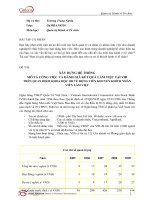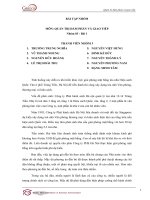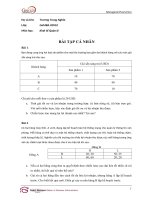Trương Trung Nghĩa - CAPSTONE PROJECT REPORT DEVELOPING THE BUSINESS STRATEGY FOR VIETTEL MOBILE IN VIETNAM FOR THE YEARS 2011-2015 pptx
Bạn đang xem bản rút gọn của tài liệu. Xem và tải ngay bản đầy đủ của tài liệu tại đây (566.76 KB, 70 trang )
2011 │ADVANCED MBA PROGRAM – GAMBA.X0510 │ Group No.09
CAPSTONE PROJECT REPORT
DEVELOPING THE BUSINESS STRATEGY FOR
VIETTEL MOBILE IN VIETNAM FOR THE
YEARS 2011-2015
Do Anh Minh
Nguyen Vinh Thu
Pham Thanh Cong
Truong Trung Nghia
Class: GaMBA.X0510
HA NOI - 2011
GRIGGS UNIVERSITY
GOLOBAL ADVANCED MASTER OF BUSINESS ADMINISTRATION PROGRAM
1
TABLE OF
CONTENTS
CONTENTS 2
LIST OF FIGURES 3
LIST OF TABLES 3
INTRODUCTION 4
CHAPTER I. THEORETICAL FOUNDATION OF STRAGIC MANAGEMENT. 6
Figure 1.1 Levels of strategic management 7
Figure 1.2 The process of strategic management 8
Figure 1.3 The PEST model (left) and Five Forces model (right) 11
Figure 1.4 The matrixes used in analyzing 12
CHAPTER II. BUSINESS SITUATION ANALYSIS OF VIETTEL GROUP 13
Figure 2.1 Revenue and profit of Viettel from 2005 to 2010 (billion VND) 16
Figure 2.2 Revenue of Viettel Mobile from 2005 to 2010 (billion VND) 17
Table 2.1 Some data on Vietnam's economy in the recent 05 years (GSO) 20
Table 2.2 Viettel’s external factor evaluation matrix (EFE) 29
Table 2.3 CPM matrix compares the competition with a number of companies 29
Table 2.4 Some financial data of Viettel from 2005 to 2010 31
Figure 2.3 Manpower of Viettel Group from 2005 to 2010 34
Table 2.5 Number of mobile phone subscribers in Vietnam (12/2010) 36
Figure 2.4 Market-share of mobile phone subscribers in Vietnam (12/2010) 37
Table 2.6 Internal factor evaluation matrix of Viettel (IFE) 39
CHAPTER III. STRATEGY SELECTION & IMPLEMENTATION SOLUTIONS
41
Table 3.1 Table of SWOT Matrix for Viettel Group 45
Table 3.2 QSPM Matrix for Viettel 51
Figure 3.1 Hierarchy of competition in Vietnam mobile market 61
Figure 3.2 Levels of competition in Vietnam mobile market 61
CONCLUSION 65
REFERENCES 67
2
LIST OF FIGURES
Figure 1.1 Levels of strategic management 7
Figure 1.2 The process of strategic management 8
Figure 1.3 The PEST model (left) and Five Forces model (right) 11
Figure 1.4 The matrixes used in analyzing 12
Figure 2.1 Revenue and profit of Viettel from 2005 to 2010 (billion VND) 16
Figure 2.2 Revenue of Viettel Mobile from 2005 to 2010 (billion VND) 17
Figure 2.3 Manpower of Viettel Group from 2005 to 2010 34
Figure 2.4 Market-share of mobile phone subscribers in Vietnam (12/2010) 37
Figure 3.1 Hierarchy of competition in Vietnam mobile market 61
Figure 3.2 Levels of competition in Vietnam mobile market 61
LIST OF TABLES
Table 2.1 Some data on Vietnam's economy in the recent 05 years (GSO) 20
Table 2.2 Viettel’s external factor evaluation matrix (EFE) 29
Table 2.3 CPM matrix compares the competition with a number of companies 29
Table 2.4 Some financial data of Viettel from 2005 to 2010 31
Table 2.5 Number of mobile phone subscribers in Vietnam (12/2010) 36
Table 2.6 Internal factor evaluation matrix of Viettel (IFE) 39
Table 3.1 Table of SWOT Matrix for Viettel Group 45
Table 3.2 QSPM Matrix for Viettel 51
3
INTRODUCTION
1. Necessity
In Vietnam, after the conversion from the command economy to market
economy, the local enterprises faced many difficulties in strategic management.
Businesses need to research, develop a strategic tool to have enough flexibility to
respond to market changes. A business strategy must be formulated on the basis of
analysis and forecast opportunities, threats, strengths and weaknesses of the enterprise,
helping businesses obtain general information about the external and internal business
environment.
Viettel Group is one successful model of change to the market economy. From a
small company, facing many difficulties, unknown brand in the market, now Viettel is
one of the leading service providers in the Vietnamese telecommunication market and
expanding to neighboring countries. The brand positioning parts the crucial part in this
achievement of Viettel.
The planning and implementation of business strategy is very important to
decide the existence and development of a company. Within the limits of the subject,
our group offers the research and analysis to introduce “Developing the business
strategy for Viettel Mobile in Vietnam for the years 2011-2015”. The research and
analysis apply the theories from the Master of Business Administration program
(MBA) offered by the Hanoi National University of Vietnam and Griggs University -
Andrews University, the United States.
2. Objective
The objective of this study is to conduct the complete top-down and competitive
analyses, develop alternative strategies and select a prioritized set of strategies that will
ensure a competitive advantage for Viettel and above normal returns (strategy to
4
expand the market of Viettel Group in Vietnam during 2011 to 2015). This study based
on the analysis and application of the theories of strategic management.
3. Subject and scope of the study
Subject of this topic is in-depth analysis, evaluation and provides the direction
to formulate a business strategy based on the theory of business strategic management.
The scope of this study based on specific statistics on the macro environment,
industry and organizational environment of the Viettel Group from 2005 to 2010 and
orientation until 2015.
4. Approaches
Topics of study based on the methodology of dialectical materialism combined
with the knowledge of strategic management subject and other subjects in the MBA
program to assess overall the business operations of telecommunications services
Viettel Group.
In addition, the research also uses methods such as statistical analysis, analytical
modeling to evaluate and develop business strategy for Viettel Telecom Group in the
field of mobile telecommunications.
5. Outline
The main contents of the analysis and strategic planning for Viettel Telecom
Group in the period of 2011 to 2015 are presented in three chapters as the following:
- Chapter I. The theoretical foundation of strategic management
- Chapter II. Analysis of business activities of Viettel Group.
- Chapter III. Strategy selection and implementation solutions.
5
CHAPTER I. THEORETICAL FOUNDATION OF STRAGIC MANAGEMENT
1.1. Concept and role of strategic management.
1.1.1. Concept.
In the early stages of the development of strategic management theory, people
have seen the strategic long term plan, are an integral part of the planning system of the
organization and thus just press strong strategic planning function. Although there are
many authors and researchers presented different ways of strategic management,
strategic management but is now both a scientific definition, and is an art and science
of planning, organization implementation and evaluation strategies.
Therefore, during the development, the concept of strategic management has
been expanded greatly. At the first phase, strategic decisions are made once for a long
period of time and it is the job of senior executives. However, the process of strategic
management is made regularly and continuously and requires the participation of all
members of the organization.
1.1.2. The role of strategic management
In the current business environment, there are opportunities and threats.
Strategic management helps us to identify opportunities and threats. The perception of
desired results and goals in the future can help managers and employees to understand
what needs to be done to achieve success. This will encourage both the above groups to
achieve short-term achievements, in order to better improve the long term welfare of
the business.
Strategic management process enables enterprises to match the proposed plan
with the external environment. The greater the volatility is, the more effort the business
has to take the initiative. To be able to survive and grow, businesses must develop their
6
own strategic management systems that can adapt with the market fluctuations.
Therefore, strategic management is in the direction of future action. It does not follow
the market but change the business environment instead.
In short, strategic management is a product of modern management science-
based practices, accumulating experiences from many companies. However, the
success of every business depends on the capacity of implementation and control of the
internal system and is seen as the state of art in business administration.
1.1.3. Types of strategy
Figure 1.1 Levels of strategic management
According to Red R.David the strategy includes only corporate and business
strategy. However, the strategy can be divided into three main categories: (i) corporate
strategy is the strategy of the corporation or company; (ii) functional strategy is to
implement a strategic business areas, business specifically; (iii) operational strategy is
the implementation strategy of the operational functions of the company's HR strategy,
marketing strategy (Figure 1.1).
Operational Strategy
Corporate
Strategy
Functional Strategy
7
1.2. Stages of strategic management
In the process of strategic management business, the administrator must perform
a series of sequential activities from strategic planning, strategy implementation and
evaluation strategy (Figure 1.2).
Figure 1.2 The process of strategic management
1.2.1. Strategy Planning
Strategic Planning is the process of identifying tasks and business objectives in
order to discover the internal strengths - weakness, external opportunities - threats to
choose an optimal strategy instead. Developing strategies includes the design and
selection of appropriate strategy for the organization. In order to do this, it should be
External
Environment
Strategic Intent
Strategic Mission
Internal
Environment
Strategy Implementation
Business
Level
Strategy
Competitive
Dynamics
Corporate
Level
Strategy
Acquisition
&
Restructure
Internation.
Strategy
Corporative
Strategies
Strategy Formulation
Corporate
Governance
Strategic
Leadership
Structure &
Control
Entrepre. &
Innovation
Strategic Competitiveness
Above Average Returns
Input
8
Feedback
considered from many different organizations and levels out the types of strategies.
Thus, strategy planning includes some processes as the following:
1. Vision, Mission, Objectives
2. Top-down analysis: PEST (Macro)
3. Stage 1: Industry (Micro, 5 forces), Business CPM/IFE/EFE
4. Stage 2: SWOT matrix
5. Stage 3: Strategy selection to reach objectives (QSPM)
1.2.1.1. Identify tasks and objectives
The first stage of strategic management is identifying tasks and objectives of the
organization. Tasks and objectives are the foundation to build up strategies.
The main objectives determine what the organization expects to meet in the
medium and long term. Most organizations pursues profit, achieve goals of excellence
leading position. The second target is the targets that the company deems necessary if
they want to achieve superior capabilities. Goals should be challenging, measurable,
consistent, logical and clear.
1.2.1.2. Analysis of external environment
The second part of the strategy is to analyze the operating environment outside
the organization. The goal of the analysis is the awareness of opportunities from which
the business environment should capture, at the same time as the threats from the
environment also provides, that can cause challenges for the company that it needs to
avoid.
1.2.1.3. Analysis of internal environment
This analysis is to find the internal strengths and weaknesses of the
organization. The organization attempts to pursue strategies to take advantage of the
strengths and improve weaknesses.
9
1.2.1.4. Choosing the optimal strategy
This was the stage to select strategies which associate with the strengths,
weaknesses, opportunities and threats identified by the company. A comparison of the
four factors is commonly known as SWOT analysis. The purpose of SWOT analysis is
to identify strategies that direction, creating a fit or mismatch between the resources
and capabilities of the company with the needs of the environment in which companies
operate.
Planning stage is an important stage that is meant to decide the entire strategic
management process. It requires the strategy to combine intuitive judgments with
systematic analysis of data in making plans and choose the alternative strategy.
1.2.2. Strategy Implementation
This was the action phase of strategic management. To implement the selected
strategy, the business should have specific plan for the organization, staffing and
appropriate funding for the mobilization and maximum use of all resources inside and
outside the organization, creating synergy and synchronization towards agreed goals.
1.2.3. Strategy Assessment
This is the final stage of strategic management. The results of implemented
strategies depend on the fluctuation of the environmental factors. Assessment focuses
on strategic issues such as review of the factors is the basis for the current strategy;
performance measurement and results achieved.
1.3. Models and matrixes
10
1.3.1. Models
• PEST model: Analysis helps to identify the external factors that are capable of
being an opportunity or challenge for companies such as political, economic, social and
technological factors…
• Five-Forces model: Analyze, forecast the competitive forces to identify
opportunities and threats. According to Michael Porter, the five forces are existing
competitors, new entrants, suppliers, buyers and substitutes.
Figure 1.3 The PEST model (left) and Five Forces model (right)
1.3.2. Matrixes
• EFE (External Factor Evaluation): Allow the company to summary and
evaluate economic, social, culture, political and other information and compete through
the grading external factors.
• IFE (Internal Factor Evaluation): Summary and evaluate strengths and
weaknesses of the company. This matrix shows the strengths that the company needs to
11
maintain and the weaknesses they needs to improve to increase their competitive
position.
Figure 1.4 The matrixes used in analyzing
• CPM (Competitive Profile Matrix): The main study subject is mentioned in this
study specializes in the field of telecommunication that is highly competitive nowadays
in Vietnam market. Some aspects of competition will be analyzed basing on the theory
of D’Avenil’s 7S framework that is a key approach, can also be used widespread in the
telecommunication industry and can be applied direct in a hypercompetitive markets.
Thus, this theory is designed to enable companies sustain the momentum of their
competitiveness through a series of initiatives that are poised to give temporary
advantages rather than structuring the company to achieve internal/external fit aimed at
maintaining equilibrium that are designed to sustain unsustainable competitive
advantages. The mentioned factors include: (i) Stakeholder satisfaction; (ii) Strategic
soothsaying; (iii) Positioning for speed; (iv) Positioning for surprise; (v) Shifting the
rule of the game; (vi) Signaling the strategic intent; and (vii) Simultaneous and
sequential strategic thrust.
STAGE 1: THE INPUT STAGE
External Factor
Evaluation (EFE)
Matrix
Competitive Profile Matrix
(CPM)
Internal Factor
Evaluation (IFE)
Matrix
STAGE 2: THE MATCHING STAGE
Strengths - Weaknesses - Opportunities - Threats (SWOT) Matrix
STAGE 3: THE DECISION STAGE
Quantitative Strategic Planning Matrix (QSPM)
12
Competitive profile matrix is used to compare the company with competitors bases
on factors that can affect the competitiveness of the companies within the industry.
This matrix helps administrators to identify their major competitors together with their
own strengths and weaknesses.
• SWOT (Strengths-Weaknesses-Opportunities-Threats): This is a combination of
the four factors that help managers to develop alternative strategies as identified in the
IFE (SW), and the EFE (OT):
- Strengths and Opportunities (SO): to promote the strengths and capture the
opportunities.
- Weaknesses and Opportunities (WO): to improve the weaknesses and seize
the opportunities.
- Strengths and Threats (ST): to utilize the strengths and avoid or minimize
the threats.
- Weaknesses and Threats (WT): defensive strategy, to improve on the
weaknesses and avoid threats.
• QSPM (Quantitative Strategy Planning Matrix): QSPM is analytical tool to
evaluate, prioritize, and select the best strategies to reach the business objectives. This
matrix requires sharp and accurate anticipation of an expert. QSPM determines the
attractiveness of different strategies by utilizing or improving external and internal
environment factors of the company. The number of strategies to be compared in a
QSPM matrix is unlimited and more matrixes can be used to compare more strategic
groups.
CHAPTER II. BUSINESS SITUATION ANALYSIS OF VIETTEL GROUP
13
2.1. Introduction of Viettel Group.
In 1989, Information Equipment Electronics Corporation was found, after more
than five years of its operation was renamed Military Telecommunications Electronics
Company, specializing in the telecommunications services in Vietnam market.
According to Decision No. 2097/2009/QD-TTg dated 14/12/2009 by the Prime
Minister, it was converted into Viettel Telecom Group. This is economic defense
business with 100% state capital, legal status, private seal, logo and organizational
charter.
• Head office: No1, Giang Van Minh St., Ba Dinh Dist., Hanoi.
• Phone: 84.04. 6255.6789, Fax: 84.04. 6299.6789
• Email: , Website: www.viettel.com.vn
Scope of business of Viettel Group includes: Supply of telecommunications
services; Telecommunications, Transmission; Post Office; Terminal distribution;
Finance investment; Media; Real Estate Investment; Export and Import, and Foreign
Investment The membership units of the group include:
• Viettel Import Export and Trading Company
• Viettel Telecom Company
• Viettel Construction Joint Stock Company
• Viettel Network Company
• Viettel International Investment Joint Stock Company
• Viettel Estate Investment & Trading Company
• Viettel Design Consultant Company
• Viettel Post Company
• Viettel New Services Development Company
• Viettel Technology Company
14
• IDC Company
• Viettel Football Club
• M1 Information Plant
• M3 Information Factory
• Viettel’s Branches at 64 provinces/ cities in the country.
2.2. Business situation of Viettel from 2005 to 2010.
Since it was renamed into Viettel Telecom Group so far, Viettel constantly
evolves and expands in both size and quality of services. Although Viettel mobile
network developed after the networks of Vinaphone, Mobifone, S-fone…, Viettel has
made progress by leaps and bounds, the number of market share has been increased,
and sales of products, services over the years constantly increase and gradually
penetrate in the foreign market. The subscribers of telecommunications services,
mobile subscribers, mobile phone subscribers in the International markets of Laos and
Cambodia have continuously grown with spectacular moves in the telecommunications
industry.
In the five years from 2005 to 2009, Viettel continuously grew its revenues by
200% year-over-year. In particular, the revenue in 2005 only gained 2,500 billion, but
in 2007, it was 16,300 billion. In the context of the world economy which was
deteriorated severely, still affected by the financial crisis and economic recession,
Viettel continued to maintain the high growth in consecutive years: in 2008, it was
33,000; in 2009, it was 60,600 and in 2010, it was VND91,134 billion. Viettel's profits,
therefore, also continuously grew nearly VND16,000 billion in 2010 (Figure 2.1). In
2010, Viettel completed comprehensively the criteria of production and business plan
set out, leading the telecommunications industry in the country. Total revenue reached
VND91.000 billion, increased 52% compared to in 2009. Payment to the State budget
15
was VND 7,628 billion, increased 45% and payment to the national defense budget
was VND215 billion. Percentage of return on average equity reached 48.3%.
Figure 2.1 Revenue and profit of Viettel from 2005 to 2010 (billion VND)
In the area of mobile telecom business, its revenues has continuously increased
year over year equivalent to the growth of the comprehensive sales. The revenues
accounted for the mobile market in 2005 only gained 1,764 billion, but in 2007 was
11,317 billion, in 2008 stopped 22,643 billion, and especially in 2009 it was greater
47,000 billion although there were facing a lot of difficulties in this time (degradation
economy, very high inflation and jobless). In the figure 2.2 hereinafter shows more
16
details and clear-cut about the revenues of Viettel mobile market in Vietnam since
2005.
Apart from business situation, Viettel currently is a unit which has the largest
telecommunications network infrastructure in Vietnam and it will continue to be
invested in expanding strongly with a large scale. Number of new transmission stations
in 2010 increased more 16,300 2G and 3G stations, and raised total stations up to
42,200, accounting for 45% of total existing stations of the enterprises providing
Vietnam’s mobile information services. With this station amount, Viettel has ensured
that each commune in the country has at least one transmission station of Viettel. At
the same time, more than 32,000 km are pulled new and increasing total of fiber optic
network up to over 120,000 km, Viettel has made photochemistry of 82% of
communes and wards across the country.
Figure 2.2 Revenue of Viettel Mobile from 2005 to 2010 (billion VND)
17
In addition to the above telecommunications infrastructure, Viettel has
conducted successful manufacture research and production of several
telecommunications equipment with the Viettel brand. The Group has researched,
made and produced successfully wireless fixed phone Homephone HP-6800 with the
output of 250,000 phones provided on the market. Continuing with this success, Viettel
has manufactured and tested continuously other products such as special phone for
offshore fishermen SeaPhone 6810, device of Dcom 3G USB, HomeGateway 3G -
modem for connection with the educational sector, for the military equipment, Viettel
has initially been successful with a number of military information machines for the
field of national security.
3G information services in 2010 was deployed and covered by Viettel in three
Indochina countries. Whole 17/17 provinces/cities across Laos country, the Unitel
mobile network has launched 3G services which bring Viettel to become the first 3G
coverage telecom enterprise in all three Indochina countries. To date, Viettel has over
18,000 stations of 3G in the three Indochina countries. With the infrastructure
advantage of a multinational investment operator, Viettel has given more incentives for
customers as implementing roaming in those countries that Viettel invests in.
In addition to the countries in Indochina area, Viettel is now stepping up
promotion of investment operation into new markets which are further and harder in
the Americas and Africa. Also as the domestic market, despite late participation,
Viettel has ranked the first infrastructure and subscription in Cambodia, Lao in
network infrastructure. Revenue in 2010 in Cambodia reached $161 million, increased
2.8 times higher than in 2009. In Laos market, it reached $61 million, increased 4.5
times. Metfone brand has been selected and awarded the best service provider of the
year by Frost & Sullivan.
18
2.3. Business environment analysis
2.3.1. External environment
2.3.1.1. Macro environment
In this section, we use the PEST model to analyze and evaluate
comprehensively the elements of macro environment affecting the mobile
telecommunications market in Vietnam in general and Viettel in particular.
• Economics (E): According to economic statistics in the period of 2005 to 2010
showing that average GDP doubled after 6 years, the accumulation of internal
economy reached over 30% of GDP. In 2010, total state revenues exceeded 12.7%
compared to the estimate (up 17.6% over 2009), total exports increased 19.1% (3 times
higher than the plan), the government’s debt balance was about 44.5% of GDP, foreign
debt balance of the nation was 42.2% of GDP and public debt balance was 56.7% of
GDP in the safety threshold.
In terms of inflation rate, Vietnam has an average inflation rate which is rather
high: prior to 2005, it was 5.35%, ranked 67th in the world and in the period of 2006-
2010 was 11.5%, ranked 24th. In the region, Vietnam is generally higher than other
countries, except in 2009. In 2010, the inflation was 11.75%, 1.5 times higher than in
India, 3 times higher than in China and 8 times in Thailand. Especially, in early 2011
so far, the inflation has increased 15.7%, increased 23% over the same period in 2010.
Currently, the Government is implementing the policies of tightening monetary,
reducing credit growth to control and prevent inflation to ensure the objectives set forth
as the total means of payment increases about 20%, the credit balance increases about
25%. VND exchange rate is operated more flexibly on the principle of market;
operation of interest rates in the diminishing mechanism and the direction, monitoring
increase to ensure the safety of credit activities
19
Table 2.1 Some data on Vietnam's economy in the recent 05 years (GSO)
Year 2005 2006 2007 2008 2009 2010
Nominal GDP (billion USD) 52 60 70 89 91 101
GDP-PPP / capita (USD) 642 730 843 1052 1064 1168
The rate of real GDP growth (%
change over the previous year)
8.4 8.2 8.5 6.2 5.3 6.7
Exports (USD billion) 32 39 48 62 57 71
Import (USD billion) 36 44 62 80 69 84
Foreign Direct Investment FDI-
registration (USD billion)
6.8 12.0 21.3 71.7 23.1 18.6
Foreign Direct Investment FDI-
Implementation (billion USD)
3.3 4.1 8.0 11.5 10 11
Remittances (USD billion) 3.8 4.7 5.5 7.2 6.2 8.1
Total retail sales and consumer
services turnover (VND1000
billion)
480 596 746 1009 1197 1561
Consumer Price Index CPI (%
change over the previous year)
8.4 6.6 12.6 19.9 6.5 11.7
Hence, with the current macroeconomic situation and the trend in the future, it
brings both opportunities and advantages for certain operation fields of Viettel. The
20
demand for mobile telecommunications services increases, but also causes difficulties,
it sought to require changes in technology, management methods to reduce costs, lower
production costs, the customer care, the tough competition in the market However,
in the long-term picture, Vietnam is still considered as one of the potential telecom
services markets, able to thrive in the future.
• Political & Legal Environment (P): our country's politics led by the Vietnamese
Communist Party are now highly appreciated in terms of stability, ensuring the
development activities of enterprises, creating safe psychology for investors to
participate in the Vietnamese market.
Vietnam’s entry in the WTO, as member of the United Nations Security
Council, the issue of globalization, foreign trend tends expanded increasingly,
integration into the world economy are the opportunities of Viettel to participate in the
global market. The regulations on administrative procedures are more completed,
business licenses are increasingly reduced. The Government is very concerned about
the performance of public administration, removing barriers in business operation. This
is an advantage for Viettel to reduce barriers to entry the industry.
Moreover, the current Vietnamese law has tended to be improved, business law is
increasingly completed. Business Law after several amendments has had clear
improvement which creates a favorable legal environment for activities of the
businesses. Commercial law, antidumping, antitrust, intellectual property protection
has initially promoted its efficiency in the market.
• Science & Technology Environment (T): Technological factor has a major
effect on business strategies of the firms as well the industries. The technology has
decisive effect on the two basic elements which create competitiveness of enterprises,
particular quality and costs of products and services that the enterprise provides for the
market.
21
Viettel, as well as other manufacturers in Vietnam go after and acquire the
existing technologies in the world. Thus, it has the conditions to select new technology
that does not take time, research and development costs. This is the strength of the
countries going behind. But it depends on the technology providers, development
expansion ability is limited. Mobile technology has now two main standards including
CDMA and GSM, in Vietnam, actually CDMA technology does not develop. All three
major companies in Vietnam are using the GSM technology and have successful
application of 3G generation and gradually testing 4G is the latest generation.
Vietnam’s production technology of terminals almost does exist, most
equipment is imported or if producing also purchases foreign technology and
components.
• Social & Culture Environment (S): In the business strategy management,
cultural - social factors are sensitive, often change. Lifestyles of the people themselves
rapidly change in the trends of the new lifestyle leading to consumer attitudes change.
When educational level is higher the increasing demand of the consumer for quality,
rich in variety of products will be higher.
Today, almost everyone from entrepreneurs, workers, farmers, students, civil
servants until students are in need of communication and other entertainments
Hence, this will enable the demand of use of telecommunications services of Viettel.
Along with the development of society in recent years, the awareness of Vietnamese is
increasingly improved; this will contribute to creating conditions for companies with
management and technique level with skilled staff and high qualification
• Demography: With the market more than 87 million people, the percentage of
young population under 27 years accounting for over 50% in need of demand
telecommunications services has been creating a vast market, and as an opportunity for
Viettel to expand its activities and continue to dominate this potential market.
22
2.3.1.2. Industry Environment
The problem here is to analyze, judge the competition powers in the mobile
telecommunications industry to identify opportunities and threats for Viettel, so we
conduct to apply Michael Porter’s model of five competitive forces of, including:
• Intensity of Rivalry: The telecommunications market is having fierce
competition of the telecommunications services companies such as Mobifone,
Vinaphone, EVN Telecom, S-fone, Beeline, Gtel Despite late participation in
telecommunications market after the networks of Vinaphone, Mobifone, now Viettel is
dominating the most market share with 36.4%. However, other mobile phone networks
are now approaching the equilibrium level as Mobifone has accounted for 28.8%,
Vinaphone has gained over 28%. If Viettel does not have appropriate policies and
strategies to maintain and develop its market share as well dominating the market
shares of competitors, then Viettel will soon give way for Mobifone, Vinaphone or
other companies.
According to the report from the Ministry of Communications and Information,
VNPT Group has officially exceeded the revenue target of VND100,000 billion in
2010, increased 22% compared with in 2009 and paid to the budget of VND7,855
billion. Viettel reached 91.134 billion, growing 50% over 2009. Saigon Post and
Telecommunications Services Corporation has obtained the revenue of VND1,165
billion. Statistics show the country has around 120 million telephone subscribers, in
which the mobile subscribers account for over 90% General report found that
telecommunications and information technology businesses have achieved spectacular
growth rates, nearly three times higher than GDP of Vietnam in 2010, reaching more
than 6.5%.
Currently, enterprises are facing many difficulties in the development of new
subscribers, the networkers are forced to perform many programs of incentives and
23
new value-added services, even many units are illegal in dumping. Vinaphone recently
sends message directly to the subscribers on the promotion program which offers two
times of the free amount of Mobile Internet package and reduction of 50% charge
exceeding the package. In addition, to keep the subscribers who are pupils, students,
Vinaphone has launched the program of presenting online English study of BEA Card;
free 1 month for service subscription fee of Ringtunes and a month of service charge
subscription of informing missed calls as activating the package of students and pupils.
Also, Mobifone has also signed the strategic cooperation with the Ho Chi Minh
Communist Youth Union Central to cooperate the organization of programs
accompanying with Vietnamese youth during the period of 2011-2014. On this
occasion, Mobifone offers Q263 packages for Union staff in all levels with incentives
and free roaming programs and monthly subscription charges along with many other
incentives
In addition to the incentive programs to attract and retain subscribers, the
networkers are actively developing value-added services to save the Average Revenue
Per User (ARPU) from the touch of alarm bar. Typically, the larger networks are
promoting the form of payment via prepaid scratch card and "shaking hands"
(collaborating) with online payment gateways to promote forms of payment through
mobile phones. The ARPU are currently about 3-4USD/subscriber/month, this number
is supposed to reach the alarm for revenue and profit threshold.
The typical small networkers like Vietnammobile and Beeline have also
announced the super packages. Vietnammobile has announced the deployment of
package "Northern SIM" for customers in 26 Northern provinces, with rates of
680VND/minute for any off-net calls or internal calls. With Beeline, to be able to win
the fourth position on Vietnam mobile market from Vietnammobile, this unit has
recently launched the billionaire package. Beeline’s use of billionaire package, the
24
subscribers charge minimum 20,000 dong to get a billion VND and free internal calls
for the first 30 days.
• Threat of New Entrants: According to the Ministry of Information &
Communications, Indochina Telecom and VTC have been licensed and now in
progress of completion of the mobile telecom network on the basis of using the
network of BTS stations and the telecommunications frequency of other networks.
MVNO cellular network model is gradually becoming popular with over 400 suppliers
worldwide. Countries that have most MVNO network are U.S. (60 MVNO/13 MnO),
Netherlands (39 MVNO / 7 MnO), and Germany (29 MVNO / 4 MnO). The biggest
advantage of MVNO Mobile is the maximum exploitation of network infrastructure.
The MVNO providers will not have to invest too much capital in building the network.
Besides, thanks to MVNO partners, MNO mobile operators will collect the invested
capital in infrastructure by fully exploiting the open market niche.
Hanoi EVN and Indochina Telecom have signed the contract for development
cooperation and common use of telecommunications infrastructure in Hanoi area. This
event marks the strategic and comprehensive partnership between a telecommunication
enterprise (Indochina Telecom) leading in the field of application of 4G world
advanced technology and Hanoi EVN, as the unit owning fiber optic transmission
infrastructure and the system of strong transmission stations in 29 districts in Hanoi;
Encouragement for businesses to share telecom infrastructure in order to save the
initial investment cost, diversification of services.
Thus, Indochina Telecom and Hanoi EVN will develop and use common
systems of telecommunications infrastructure including: the BTS, the wave
transmission columns and the entire optical fiber transmission lines which are available
for service deployment of Wimax 4G services and other telecommunications services
in Hanoi. Initially, Indochina Telecom will deploy more than 100 base transceiver
25









